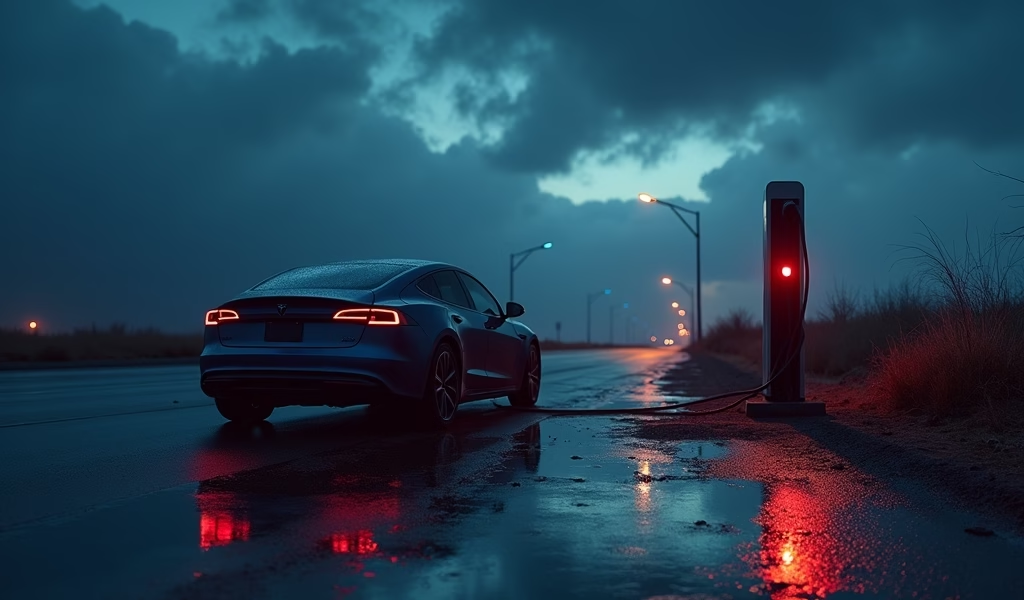Overview
This article explains five key aspects of electric vehicles: understanding range capabilities (150-400+ miles per charge), charging options (home and expanding public infrastructure), battery maintenance (simpler than gas vehicles), cost considerations (higher upfront cost but lower lifetime expenses), and environmental benefits (significantly reduced emissions over vehicle lifetime). EVs offer advantages in performance, convenience, and sustainability while requiring different planning approaches than traditional vehicles, with most current models exceeding typical daily driving needs.
Electric Vehicles Explained: 5 Pro Tips for Navigating the EV Revolution
Table of Contents
- Introduction to Electric Vehicles
- How Electric Vehicles Work
- Pro Tip 1: Understanding EV Range
- Pro Tip 2: Charging Infrastructure and Options
- Pro Tip 3: Battery Health and Maintenance
- Pro Tip 4: Cost Considerations
- Pro Tip 5: Environmental Impact
- Conclusion
- Frequently Asked Questions
Introduction to Electric Vehicles
Electric vehicles are transforming our roads, but they still mystify many drivers who’ve spent decades with traditional combustion engines. As a master technician with 20+ years under my belt, I’ve watched EVs evolve from quirky experiments to mainstream options that deliver impressive performance while reducing our dependence on fossil fuels.
Just last week, Sarah walked into our dealership looking confused. “I’m considering an electric car, but I don’t even know where to start,” she confessed. After spending her entire driving life with gas vehicles, the prospect of going electric felt overwhelming. By the end of our conversation, she left with a clear understanding of how EVs could fit into her lifestyle and a test drive scheduled for the following day.
Whether you’re EV-curious or actively shopping, understanding the fundamentals of electric vehicles helps you make informed decisions about this exciting technology. In this comprehensive guide to electric vehicles explained, I’ll share five professional tips that demystify EVs and help you determine if they’re right for your driving needs.
The shift toward electrification represents one of the biggest changes in automotive history since we moved from horses to horsepower. Let’s plug in and power up your EV knowledge!
How Electric Vehicles Work
At their core, electric vehicles operate on a beautifully simple principle compared to the complexity of internal combustion engines. Instead of the hundreds of moving parts in traditional vehicles, EVs rely primarily on an electric motor (or motors) powered by a battery pack.
When you press the accelerator in an EV, you’re essentially controlling how much electricity flows from the battery to the motor. This creates immediate torque—the reason EVs feel so zippy from a standstill. There’s no need for the engine to build up revolutions or for transmission to shift through gears; power delivery happens instantaneously.
Most modern electric vehicles use lithium-ion battery technology similar to what powers your smartphone, just scaled up dramatically. These batteries store energy that’s used to drive the electric motors. When the battery depletes, you recharge it by plugging into an electrical source rather than filling a tank with gasoline.
One of the most significant differences you’ll notice in an EV is regenerative braking. When you lift off the accelerator or press the brake pedal, the electric motor works in reverse, converting kinetic energy back into electricity that recharges the battery. This is why many driving an electric car feels like a one-pedal experience in certain modes – the vehicle slows significantly just by easing off the accelerator.
The beauty of electric propulsion lies in its efficiency. According to the U.S. Department of Energy, electric vehicles convert about 59-62% of electrical energy from the grid to power at the wheels, while conventional gasoline vehicles only convert about 17-21% of the energy from gasoline to power at the wheels.

Pro Tip 1: Understanding EV Range
Range anxiety—the fear of running out of battery power before reaching a charging station—remains the top concern for potential EV buyers. Let me put your mind at ease: modern electric vehicles have come a long way in addressing this issue.
Today’s EVs typically offer between 150 to 300+ miles of range per charge, with premium models pushing beyond 400 miles. For context, the average American drives about 37 miles per day. Do the math, and you’ll see most EVs can handle several days of typical driving between charges.
However, real-world range varies based on several factors:
- Driving style: Aggressive acceleration and high speeds drain batteries faster
- Temperature: Extreme cold or heat can reduce range by 10-40%
- Terrain: Mountainous routes consume more energy than flat roads
- Climate control: Running heat or AC draws additional power
- Battery age: Like all batteries, EV batteries gradually lose capacity over time
I always tell customers like Michael, who recently visited with concerns about making his weekly 120-mile round-trip to visit family, to consider their typical driving patterns honestly. After discussing his routine, we determined that even with highway driving and occasional climate control use, a mid-range EV with 250+ miles of range would comfortably meet his needs with plenty of buffer.
Many EVs now include sophisticated trip planners that factor in elevation changes, temperature, and available charging stations along your route. These tools accurately predict where and when you’ll need to charge, virtually eliminating the guesswork that contributed to range anxiety in earlier EV generations.
Remember, the displayed range in an EV is an estimate based on recent driving conditions and habits. Think of it like a gas gauge that adapts to your driving style rather than a fixed number. Many facts about electric cars show that drivers quickly adapt to this new way of thinking about vehicle range.
Pro Tip 2: Charging Infrastructure and Options
Understanding EV charging is essential for a smooth transition to electric driving. Unlike gas vehicles that require dedicated trips to refueling stations, EVs offer multiple charging options that integrate seamlessly into your daily routine.
There are three primary charging levels:
- Level 1 (120V): Uses a standard household outlet, adding about 3-5 miles of range per hour. While slow, it’s sufficient for overnight charging if you drive less than 40-50 miles daily.
- Level 2 (240V): Requires installation similar to an electric dryer outlet, delivering 15-40 miles of range per hour. This is the sweet spot for home charging, fully replenishing most EVs overnight.
- DC Fast Charging (Level 3): High-powered stations that can add 100-200 miles of range in about 30 minutes, depending on the vehicle and charger capabilities.
For home charging, I typically recommend a Level 2 charger installation. While it represents an upfront investment of $500-$1,500 (including installation), the convenience is worth it. Many utility companies offer rebates or incentives for home charger installation, and some EV purchases include installation services.
Public charging infrastructure continues to expand rapidly. According to the Alternative Fuels Data Center, there are now over 50,000 public charging stations with more than 130,000 individual charging ports across the United States, with that number growing monthly.
When Christina visited our dealership concerned about charging during her regular road trips to visit her grandchildren 200 miles away, we mapped out the fast-charging stations along her route. She was surprised to discover multiple convenient options near restaurants where she typically stops for lunch anyway.
Smart charging habits make all the difference in EV ownership. Most EV drivers charge at home overnight when electricity rates are lower, waking up to a “full tank” each morning. For longer trips, a bit of pre-planning using apps like PlugShare or your vehicle’s built-in navigation system ensures you’re never far from a charging option.
Pro Tip 3: Battery Health and Maintenance
EV batteries represent the heart of electric vehicles, and proper care ensures they’ll maintain optimal performance for years. The good news? Battery maintenance is significantly simpler than caring for combustion engines.
Modern EV batteries are designed to last the lifetime of the vehicle, with most manufacturers offering 8-10 year/100,000+ mile warranties on their battery systems. Real-world data shows many EV batteries retain 70-80% of their original capacity even after a decade of use.
To maximize battery longevity:
- Avoid routinely charging to 100% or depleting below 10% when possible
- Use scheduled charging to finish shortly before departure rather than leaving the vehicle at full charge for extended periods
- Limit DC fast charging to when necessary for long trips, as frequent rapid charging generates more heat
- Park in moderate temperatures when possible (garage parking helps in extreme climates)
Many customers ask about battery replacement costs. While these costs are declining steadily as technology improves and production scales up, the reality is most EV owners will never need to replace their battery. Battery management systems have become increasingly sophisticated, preventing the conditions that lead to premature degradation.
Beyond battery care, EVs require minimal maintenance compared to traditional vehicles. You’ll never need oil changes, transmission services, or timing belt replacements. Even brake pads last significantly longer thanks to regenerative braking reducing physical brake use.
Your regular maintenance schedule will primarily consist of:
- Tire rotations and replacements
- Cabin air filter changes
- Brake fluid flush every 2-3 years
- Coolant system service (typically after 100,000+ miles)
This simplified maintenance schedule translates to significant savings over the vehicle’s lifetime. According to Consumer Reports, EV owners pay about half as much for maintenance and repair compared to owners of gas-powered vehicles.

Pro Tip 4: Cost Considerations
Let’s talk dollars and cents. While the upfront purchase price of electric vehicles typically exceeds comparable gas models, the total cost of ownership often tells a different story.
The initial price gap continues to narrow as battery costs decline and production scales up. Additionally, federal tax credits of up to $7,500 are available for many EV models, with additional state and local incentives potentially adding thousands more in savings. These incentives can dramatically reduce the effective purchase price.
Where EVs truly shine is in operational costs:
- Fuel savings: Electricity costs significantly less than gasoline per mile. The average EV owner saves $800-$1,000 annually on fuel costs.
- Maintenance reduction: With fewer moving parts and no oil changes, EVs typically save $4,600 in maintenance costs over the vehicle’s lifetime.
- Longevity potential: Electric motors can outlast internal combustion engines, potentially extending vehicle lifespan.
- Resale value: Many EVs, particularly those with strong battery warranties and software update support, hold value competitively.
I recently helped Tom, a local delivery driver who puts nearly 25,000 miles annually on his vehicle, analyze the economics of switching to an EV. Despite the higher upfront cost, his break-even point came at just under three years when factoring in fuel savings, reduced maintenance, and available incentives. Beyond that point, he’ll save approximately $3,500 annually compared to his current gas vehicle.
Insurance costs for EVs have historically been slightly higher due to specialized repair needs and parts costs, but this gap is narrowing as repair networks expand their EV capabilities. Some insurance companies now offer discounts for electric vehicles, recognizing their advanced safety features and lower fire risk compared to gas vehicles.
When evaluating the advantages and disadvantages of electric cars, the financial equation increasingly favors electric options for many drivers, especially those who:
- Drive higher-than-average annual mileage
- Keep vehicles for 5+ years
- Can charge at home using standard electricity rates or time-of-use plans
- Qualify for available tax incentives and rebates
Pro Tip 5: Environmental Impact
The environmental benefits of electric vehicles extend far beyond the obvious absence of tailpipe emissions. Let’s break down the full lifecycle impact to provide a clear picture.
EVs start with a higher carbon footprint during manufacturing, primarily due to battery production. However, they quickly overcome this deficit through operational efficiency. According to research from the International Council on Clean Transportation, even when powered by the average European electricity grid mix, an electric car’s lifetime emissions are already 66-69% lower than comparable gasoline vehicles.
This advantage grows even stronger as electricity generation continues shifting toward renewable sources. In regions with cleaner grids (like the Pacific Northwest or France), the lifetime emissions reduction can exceed 80% compared to gas vehicles.
Beyond carbon emissions, EVs eliminate other pollutants associated with internal combustion engines:
- No nitrogen oxides (NOx) or particulate matter that contribute to respiratory diseases
- Elimination of oil leaks that contaminate soil and water
- Reduced noise pollution in urban environments
Battery recycling technology continues to advance rapidly. Modern EV batteries maintain significant value after automotive use, with materials that can be repurposed for stationary storage or recycled for new battery production. Several automakers have established closed-loop recycling programs to recover critical minerals and reduce the need for new mining operations.
When Rachel visited our dealership concerned about trading her fuel-efficient hybrid for an EV due to battery production impacts, we discussed how quickly the operational benefits offset manufacturing emissions—typically within 6-18 months of driving, depending on her local grid mix and driving patterns. Understanding the complete lifecycle helped her make an informed decision aligned with her environmental values.
For environmentally conscious drivers, combining EV ownership with home solar installation creates a particularly powerful sustainability solution. This pairing allows for truly zero-emission driving while potentially achieving energy independence and protection from rising utility costs.
Conclusion
Electric vehicles represent not just a change in what powers our cars, but a fundamental shift in how we think about transportation, energy, and our relationship with vehicles. As we’ve explored throughout this electric vehicles explained guide, EVs offer compelling advantages in performance, convenience, cost savings, and environmental impact.
The technology continues advancing rapidly, with each new model generation bringing longer range, faster charging, and more accessible price points. What once seemed futuristic is now firmly mainstream, with electric options available across nearly every vehicle segment from compact cars to pickup trucks.
If you’re considering making the switch to electric, start by honestly evaluating your driving patterns and charging options. Most drivers discover that current EV capabilities already exceed their daily needs, with the convenience of home charging eliminating trips to gas stations for all but the longest journeys.
The transition to electric driving involves some adjustment in habits and thinking, but most new EV owners report they would never return to internal combustion engines. The instant torque, smooth acceleration, quiet operation, and reduced maintenance create a superior driving experience that combustion engines simply cannot match.
Ready to learn more about electric vehicles and stay updated on the latest developments? Sign up for our monthly newsletter below. We’ll send you expert maintenance tips, industry news, and exclusive offers to help you navigate the electric revolution.
Stay Charged Up: Get EV Updates & Tips
Join our community of EV enthusiasts and receive monthly insights on maximizing your electric driving experience.
We respect your privacy and will never share your information. Unsubscribe anytime.
Whether you’re taking your first steps toward electric mobility or already enjoying the benefits of EV ownership, the road ahead is exciting. The electric revolution is well underway, and it’s transforming our driving experience for the better—one silent, powerful mile at a time.
Frequently Asked Questions
How long does it take to charge an electric vehicle?
Charging time varies by method: Level 1 (standard outlet) adds 3-5 miles per hour, Level 2 (240V) adds 15-40 miles per hour, and DC Fast Charging can add 100-200 miles in 30 minutes. Most owners charge overnight at home and rarely need to wait for charging.
How much does it cost to install a home charger?
Level 2 home chargers typically cost $500-700 for the unit plus $500-1,000 for professional installation. Many utilities and states offer rebates that can cover a significant portion of these costs.
Do electric vehicles work in cold weather?
Yes, EVs function well in cold weather, though range may decrease by 10-40% in extreme cold due to battery chemistry and heating needs. Modern EVs include battery thermal management systems that minimize this impact.
How long do electric vehicle batteries last?
Most EV batteries are warrantied for 8-10 years or 100,000+ miles and typically retain 70-80% of original capacity after 10 years. Many EVs will likely outlast their combustion counterparts in total lifespan.
Can I take road trips in an electric vehicle?
Absolutely! Modern EVs easily handle road trips with ranges of 200-400+ miles per charge and expanding fast-charging networks along major routes. Trip planning apps make finding convenient charging stops simple and stress-free.

